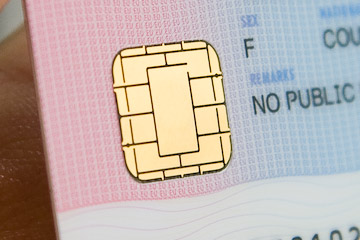ID card's gold is just for show

Contact plate is triumph of form not function
Critics of the government's ID card project have long questioned its usefulness - but it has now emerged that one of the card's most eye-catching elements doesn't actually do anything.
ID cards issued in the UK currently carry a gold-coloured contact plate, similar to those found on credit cards with chip and PIN functionality.
These contact plates normally allow card readers to connect to the chip inside the card, in order to carry out an electronic transaction such as authorising a payment.
But the contact plate on current ID cards cannot be used to carry out any sort of electronic transaction: the chip inside the card doesn't contain the information necessary to connect to a card reader via the plate.
Instead, the chips must be read wirelessly through RFID - meaning the contact plate is essentially redundant.

The dummy plate that can be found on the rear of British and foreign national ID cards
(Photo credit: Chris Beaumont/silicon.com)
Dave Birch, director of electronic transaction company Consult Hyperion, revealed on a blog: "The ID cards issued in the UK have a contact plate on them, but it is only for show, since there are no services accessible through the contact interface."
"Surely it would have saved a lot of money to have just printed a picture of a shiny gold contact plate on the back of the card somewhere," he added.
It is thought the decision to use the dummy plate was taken for design reasons. By using a dummy plate, the card won't have to be redesigned should a functioning plate be added at a later date.
Similarly, by using a dummy plate in the current generation of ID cards, the manufacturing process won't have to be altered if a functioning plate is subsequently included on the card. If the next generation of cards saw the addition of the contact plate for the first time however, the manufacturing process would have to be retooled - for example, increasing the thickness of the card to accommodate the plate.
A Home Office spokesman said: "The contact plate is present to maintain continuity of design with similar products now, or in the future, that make use of a contact plate."
More than 7,000 ID cards have been issued to British public since the UK cards were made available last year, starting in Manchester before rolling out across the North West and to select groups across the UK. ID cards have also been issued to foreign nationals living in Britain since November 2008.
The chip inside British and foreign national ID cards, which contains the cardholder's biographic and biometric details, is accessed via specialised RFID readers. These readers are being used at UK borders to verify the identity of cardholders.
The readers were not, however, rolled out to UK border guards until October 2009, almost a year after the cards were first introduced for foreign nationals.
The design of the ID card for British nationals has also been criticised by the financial services industry for offering few features and limiting the uses that the card could be put to.
Last month silicon.com revealed that the government was considering releasing an upgraded ID card in 2012 with a raft of new features, including authorising online transactions using chip and PIN and verifying the cardholder's identity over the internet.